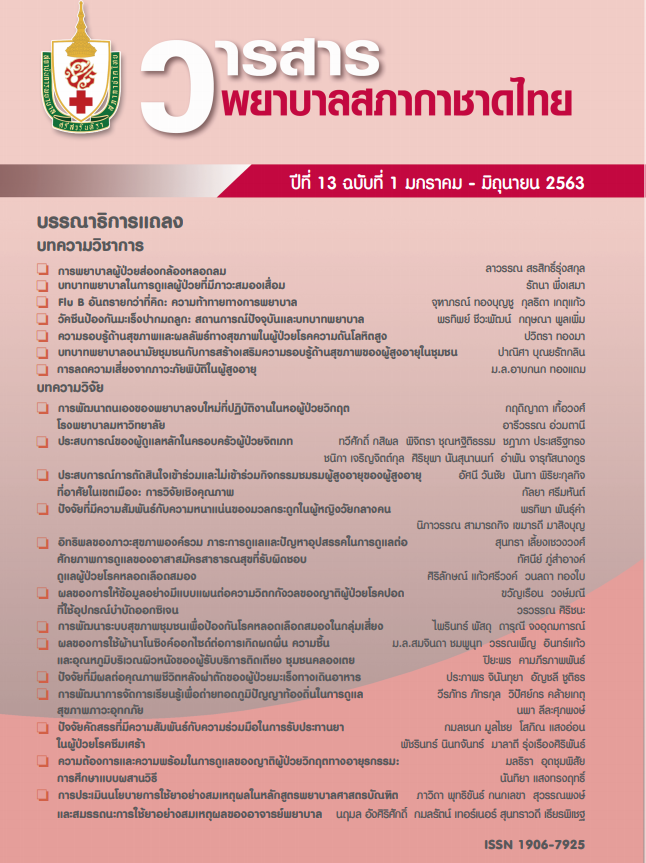HPV Vaccine: Current Situation and Nurses’ Roles
Keywords:
HPV vaccine, cervical cancerAbstract
Cervical cancer is one of the most common types of cancer in Thai women which is mainly caused by the Human Papilloma Virus (HPV). Nowadays, HPV vaccines have been developed to prevent cervical cancer. It was found that in Thailand, not every group of people vulnerable to the disease have access to HPV vaccines, while nurses’ knowledge related to HPV vaccine is at a moderate level. Moreover, clients also lack sufficient information about HPV vaccines. Therefore, it is important for nurses to take a key role in increasing the success of HPV vaccination. There should be up-to-date training regarding HPV infection and vaccine for nurses. Children, teenagers and parents should be appropriately educated and receive accurate information regarding cervical cancer, advantages of the HPV vaccine, and ways vaccination should be administrated as well as its limitation. A proactive approach should be taken in providing services in order to prevent cervical cancer and administering of the HPV vaccination. Research on the causes of difficulties and barriers to receiving the vaccination should be conducted.
References
2. Strategy and Planning Division, Office of the Permanent Secretary. Public Health Statistics A.D.2018. Nonthaburi: Ministry of Public Health; 2018.
3. World Health Organization. Human Papillomavirus vaccines. WHO position paper. Wkly Epidemiol Rec 2009;84(15):118-31.
4. Bruni L, Barrionuevo-Rosas L, Albero G, Serrano B, Mena M, Gómez D, et al. Human papillomavirus and related diseases report in Thailand. Summary Report. n.p.: ICO Information Centre on HPV and Cancer (HPV Information Centre); 2017.
5. Srisomboon J, Termrungruanglert W. HPV Vaccine. In: Srisomboon J, Kietpeerakool C., editors. Gynecologic Oncology. Bangkok: RTCOG; 2010. p. 33-46 (in Thai)
6. Galani E, Christodoulou C. Human papilloma viruses and cancer in the post-vaccine era. Clin Microbiol Infect 2009;15(11):977-81.
7. Hutchison DJ, Klein KC. Human papillomavirus disease and vaccines. Am J Health Syst Pharm 2008;65(22):2105-12.
8. ACOG Committee on Practice Bulletins-Gynecology. ACOG Practice Bulletin No.109: Cervical cytology screening. Obstet Gynecol 2009;114(6):1409-20.
9. Dawar M, Deeks S, Dobson S. Human papillomavirus vaccines launch a new era in cervical cancer prevention. CMAJ 2007;177(5):456-61.
10. Smith JS, Lindsay L, Hoots B, Keys J, Franceschi S, Winer R, Clifford GM. Human papillomavirus type distribution in invasive cervical cancer and high-grade cervical lesions: a meta-analysis update. Int J Cancer 2007;121(3):621-32.
11. World Health Organization. HPV infection and cervical cancer [Internet]. 2016 [Cited 2017 Dec 17]. Available from: http://apps.who.int/iris/bitstream/10665/253123/1/9789241549769-eng.pdf?ua=1.
12. Viens LJ, Henley SJ, Watson M, Markowitz LE, Thomas CC, Thompson TD, et al. Human Papillomavirus-Associated Cancers-United States, 2008–2012. MMWR Morb Mortal Wkly Rep 2016;65(26):661-6.
13. De Vuyst H, Clifford GM, Nascimento MC, Madeleine MM, Franceschi S. Prevalence and type distribution of human papillomavirus in carcinoma and intraepithelial neoplasia of the vulva, vagina and anus: a meta-analysis. Int J Cancer 2009;124(7):1626-36.
14. Ault KA. Human papillomavirus vaccines: an update for gynecologists. Clin Obstet Gynecol 2008;51(3):527-32.
15. Hakim AA, Dinh TA. Worldwide impact of the human papillomavirus vaccine. Curr Treat Options Oncol 2009;10(1-2):44-53.
16. World Health Organization. Human papillomavirus vaccines: WHO position paper. Wkly Epidemiol Rec 2014;43(89):465-92.
17. Markowitz LE, Dunne EF, Saraiya M, Chesson HW, Curtis CR, Gee J, et al. Human papillomavirus vaccination: recommendations of the Advisory Committee on Immunization Practices (ACIP). MMWR Recomm Rep 2014; 63(RR-05):1-30.
18. Petrosky E, Bocchini JA Jr, Hariri S, Chesson H, Curtis R, Saraiya M, et al. Use of 9-valent Human Papillomavirus (HPV) vaccine: updated HPV vaccination recommendations of the advisory committee on immunization practices. MMWR Morb Mortal Wkly Rep 2015;64(11):300-4.
19. Kash N, Lee MA, Kollipara R, Downing C, Guidry J, Tyring SK. Safety and efficacy data on vaccines and immunization to human papillomavirus. J Clin Med 2015;4(4):614-33.
20. Chichareon S, Herrero R, Munoz N, Bosch FX, Jacobs MV, Deacon J, et al. Risk factors for cervical cancer in Thailand: a case-control study. J Natl Cancer Inst 1998;90(1):50-7.
21. Hakim AA, Lin PS, Wilczynski S, Nquyen K, Lynes B, Wakabayashi MT. Indications and efficacy of the human papillomavirus vaccine. Curr Treat Options Oncol 2007;8(6):393-401.
22. Termrungruang W, Kasemsarn P, Srisomboon J. HPV-related diseases and HPV vaccines. HPV newsletter. Bangkok: Rakluke Publishing Service; 2010. (in Thai)
23. Kim JJ, Goldie SJ. Cost effectiveness analysis of including boys in a human papillomavirus vaccination programme in the United States. BMJ 2009;339:b3884. doi: 10.1136/bmj.b3884
24. Meites E, Kempe A, Markowitz LE. Use of a 2-dose schedule for human papillomavirus vaccination-updated recommendations of the advisory committee on immunization practices. MMWR 2016;65(49):1405-8.
25. World Health Organization. WHO recommendations for HPV vaccination [Internet]. 2016 [cited 2017 Dec 17]. Available from: http://apps.who.int/iris/bitstream/10665/253123/1/9789241549769-eng.pdf?ua=1.
26. Talungchit P. Accessibility to Reproductive Health Care Service of Adolescents. In: Tanmahasamut P, Chanprapaph P, Jaishuen A, Wongwananuruk T, Lertbunnaphong T, editors. OB-GYN in practice 2014. Bangkok: Department of Obstetrics and Gynecology, Faculty of Medicine Siriraj Hospital Mahidol University; 2014. p. 1-6. (in Thai)
27. Songthap A, Pitisuttithum P, Kaewkungwal J, Fungladda W, Bussaratid V, Koonsaeng S. Knowledge, attitudes, and acceptability of a human papillomavirus vaccine among healthcare providers. Southeast Asian J Trop Med Public Health 2009;40(5):1048-56.
28. World Health Organization. Implementation-training, service delivery and supervision [Internet]. 2016 [cited 2017 Dec 17]. Available from: http://apps.who.int/iris/bitstream/10665/253123/1/9789241549769-eng.pdf?ua=1.
29. World Health Organization. Developing a communication plan [Internet]. 2016 [cited 2017 Dec 17]. Available from: http://apps.who.int/iris/bitstream/10665/253123/1/9789241549769-eng.pdf?ua=1.
30. Gerend MA, Lee SC, Shepherd JE. Predictors of human papillomavirus vaccination acceptability among underserved women. Sex Transm Dis 2007;34(7):468-71.
Downloads
Published
Issue
Section
License
เนื้อหาบทความหรือข้อคิดเห็นต่างๆ ในวารสารพยาบาลสภากาชาดไทยนี้ เป็นความคิดเห็นของผู้เขียนบทความ ไม่ใช่ความเห็นของกองบรรณาธิการ หรือสถาบันการพยาบาลศรีสวรินทิรา สภากาชาดไทย





